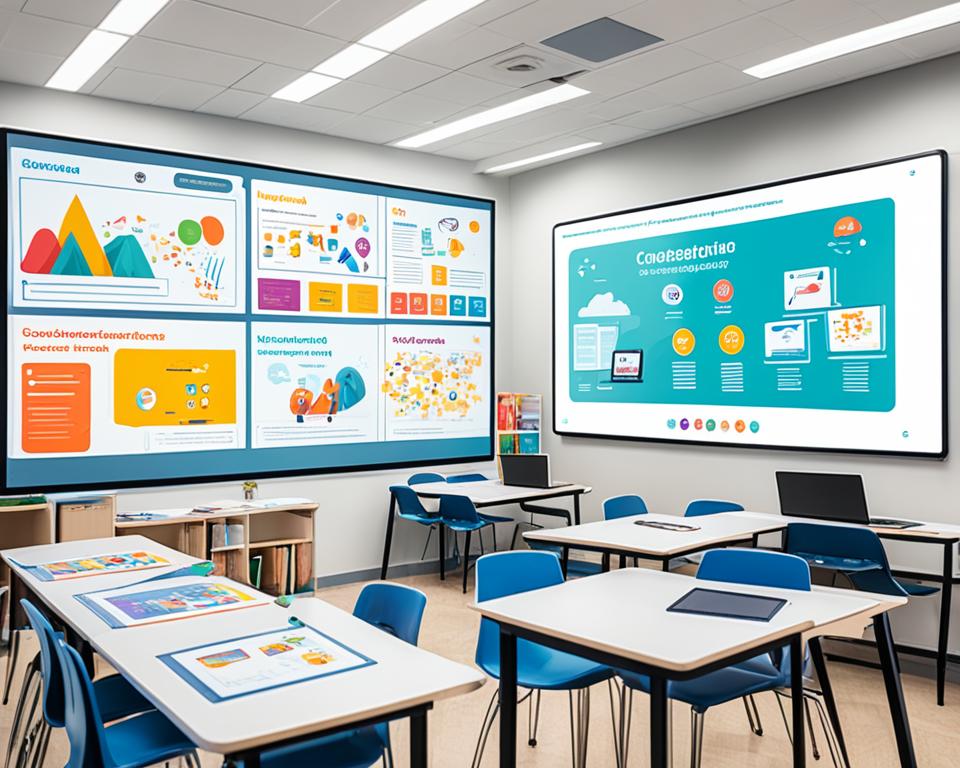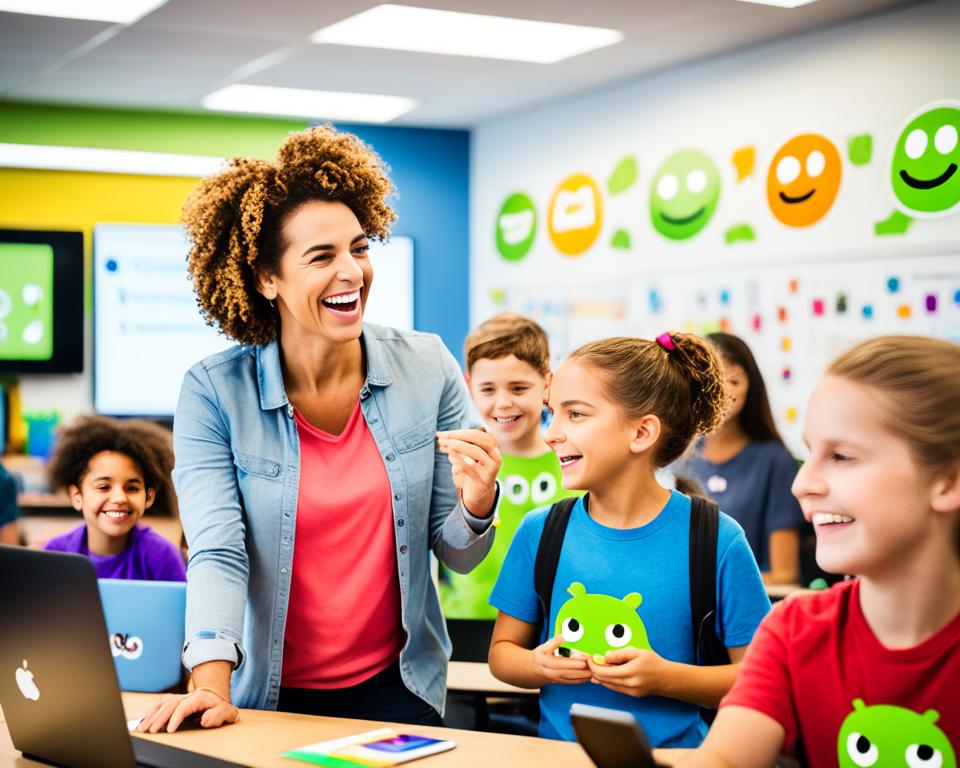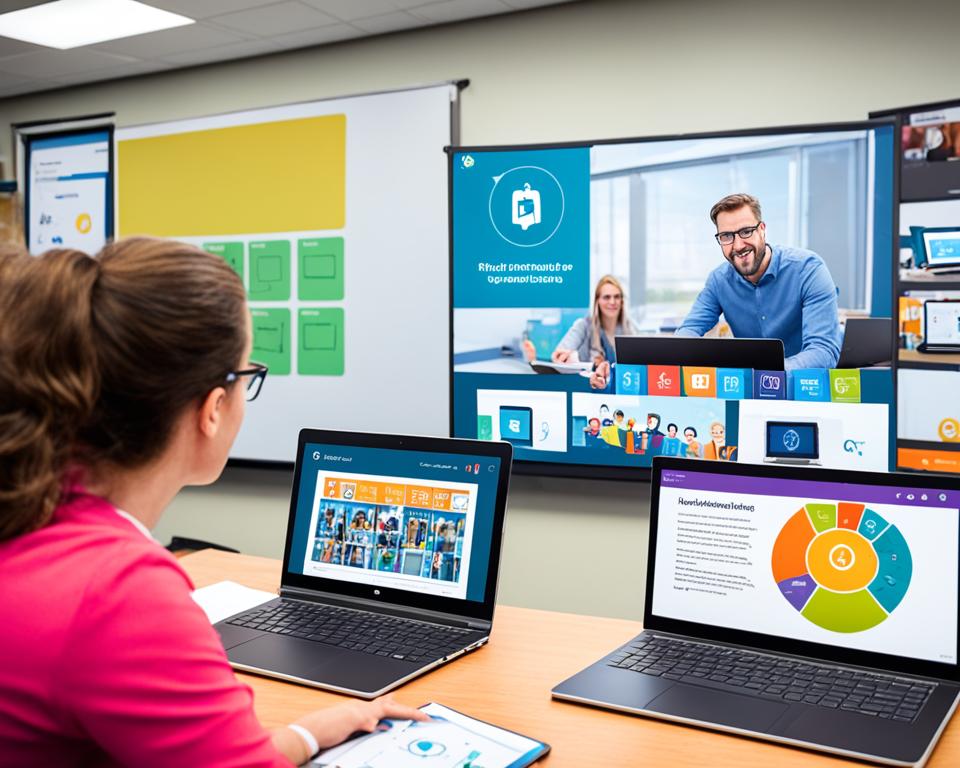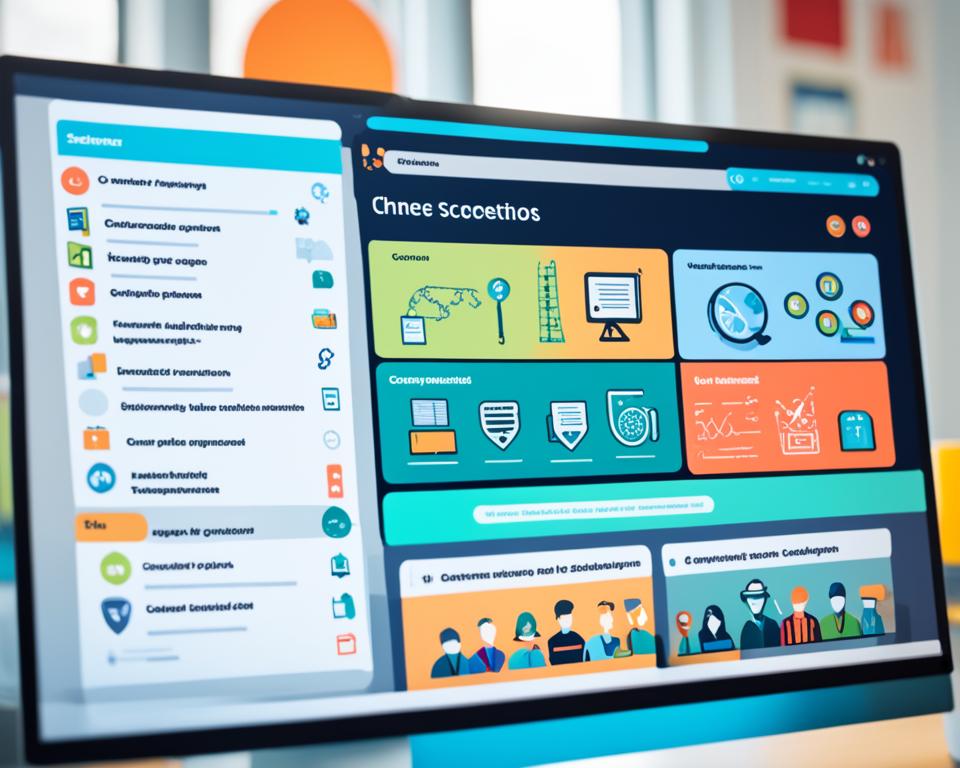Online teaching has become increasingly important in today’s educational landscape, especially with the disruptions caused by COVID-19. Several technologies and platforms have proven to be effective in enhancing virtual learning experiences and maximizing student engagement. In this article, we will explore some of the top technologies and platforms that educators can utilize for online teaching.
Key Takeaways:
- Effective technologies and platforms play a crucial role in online teaching.
- Digital platforms and e-learning tools enable virtual learning experiences.
- Online course platforms provide comprehensive solutions for distance learning.
- Educational technology enhances engagement and facilitates virtual classrooms.
- Virtual learning platforms like Google Classroom and Blackboard streamline remote teaching.
Google Classroom: Streamlined Remote Teaching
Google Classroom is a versatile and user-friendly online learning platform designed to facilitate remote teaching and enhance the digital learning experience. As part of Google’s suite of educational tools, Google Classroom offers a seamless and efficient solution for educators to manage instructional content, assign work, conduct assessments, and provide personalized feedback.
With Google Classroom, teachers can easily share instructional materials such as presentations, documents, and videos with their students, ensuring everyone has access to the necessary resources. The platform allows for the creation of virtual classrooms where teachers can post announcements, distribute assignments, and engage in interactive discussions.
One of the key benefits of Google Classroom is its ability to streamline the remote teaching process. Teachers can efficiently organize their classes, track student progress, and communicate with students and parents, all within a single platform. This centralized approach eliminates the need for multiple tools and platforms, saving time and ensuring that both teachers and students can focus on the learning experience.
Features of Google Classroom
1. Instructional Content Sharing: Teachers can easily upload and share instructional content, including documents, presentations, and multimedia files.
2. Work Assignments: Assignments can be created and distributed to students, complete with due dates and attachments. Students can also submit their work directly through Google Classroom.
3. Assessments: Teachers can create quizzes and tests using Google Forms or other assessment tools and assign them to students. The platform provides instant grading and feedback.
4. Personalized Feedback: Teachers can provide individualized feedback to students on their assignments and assessments, promoting a tailored learning experience.
5. Classroom Discussions: Google Classroom allows for interactive discussions among students and teachers, fostering collaboration and engagement within the virtual classroom.
Google Classroom’s intuitive interface and seamless integration with other Google tools, such as Google Drive and Google Docs, make it an ideal choice for educators seeking to adapt to remote teaching. It provides a structured and organized platform that promotes effective communication, enhances student engagement, and enables personalized learning in the digital realm.
With Google Classroom, teachers can create a virtual classroom environment that mirrors the traditional classroom experience, ensuring a smooth transition to remote teaching and enabling students to continue their educational journey effectively.
Blackboard: Comprehensive Digital Learning Platform
Blackboard is a comprehensive digital learning platform that provides educators with a wide range of tools and features to enhance the online teaching experience. Whether it’s live teaching sessions or on-demand educational solutions, Blackboard offers a robust and intuitive platform for educators to create engaging virtual classrooms.
One of the key features of Blackboard is its video conferencing capabilities, allowing teachers to conduct live teaching sessions and interact with students in real time. With this feature, educators can deliver lessons, answer questions, and facilitate discussions as if they were in a traditional classroom setting.
A standout feature of Blackboard is the virtual blackboard, which enables teachers to present and explain concepts using an interactive whiteboard interface. This tool allows for real-time collaboration and note-taking, creating an engaging learning experience for students.
Breakout groups are another valuable feature offered by Blackboard. This functionality allows teachers to divide students into smaller groups for collaborative work and discussions. It promotes active participation and fosters teamwork among students, enhancing their learning experience.
Blackboard also provides a range of interactive tools and resources to engage students and promote active learning. These include multimedia presentations, quizzes, discussion boards, and assignments. With these tools, educators can create diverse and interactive learning experiences that cater to different learning styles.
By utilizing Blackboard, teachers can easily manage their courses, monitor student progress, and communicate with parents. The platform offers seamless integration with other educational tools and systems, simplifying the workflow and improving efficiency.
Overall, Blackboard is a comprehensive digital learning platform that empowers educators to deliver high-quality online education. Its live teaching capabilities, virtual blackboard, breakout groups, and interactive tools contribute to creating immersive and effective virtual classrooms.

| Features | Benefits |
|---|---|
| Video conferencing | Facilitates live teaching sessions and real-time interaction with students |
| Virtual blackboard | Enables interactive presentations and explanations using an intuitive whiteboard interface |
| Breakout groups | Promotes collaborative work and discussions among students in smaller groups |
| Interactive tools and resources | Engages students through multimedia presentations, quizzes, discussions, and assignments |
| Course management and communication | Simplifies course administration, student progress monitoring, and parent communication |
Solfeg.io: Engaging Music Education
Solfeg.io is the perfect solution for K-12 music educators who want to create an interactive and engaging music education experience for their students. With its web-based audio player and visual display, Solfeg.io brings music to life in a whole new way.
The web-based audio player in Solfeg.io allows students to listen to songs while following along with the visual display of the melody, chords, and rhythm in real time. This innovative feature enhances students’ understanding of music theory and helps them develop a deeper appreciation for different musical elements.
But Solfeg.io doesn’t stop there. It also offers a wide range of educational exercises and video tutorials that supplement the learning process. These resources reinforce the lessons taught and provide students with opportunities to practice their skills and improve their musical abilities.
With Solfeg.io, K-12 music educators can create customized lesson plans, assign exercises, and monitor student progress all within a single platform. This makes it easier than ever to track students’ growth and provide targeted feedback to help them succeed.
Furthermore, Solfeg.io’s user-friendly interface and intuitive design make it accessible to students of all ages and skill levels. Whether they are just starting their musical journey or have already developed a passion for music, Solfeg.io caters to their individual needs and fosters a love for music that goes beyond the classroom.
As a web-based platform, Solfeg.io is easily accessible from any device with an internet connection, making it convenient for both in-person and remote learning environments. This flexibility ensures that music education remains an integral part of K-12 education, regardless of the circumstances.
So if you’re a K-12 music educator looking to enhance your teaching and engage your students in a dynamic music education experience, Solfeg.io is the perfect tool for you. Try it today and bring the joy of music to your classroom!
Key Features of Solfeg.io
- Web-based audio player with a visual display of melody, chords, and rhythm
- Educational exercises and video tutorials to reinforce learning
- Customizable lesson plans and assignments
- Student progress monitoring and targeted feedback
- User-friendly interface for students of all ages and skill levels
- Accessible from any device with an internet connection
Insert Learning: Interactive Lessons from the Internet
Insert Learning is an innovative online learning platform that empowers teachers to create interactive and engaging lessons by leveraging the vast resources available on the internet. By seamlessly integrating instructional content, questions, videos, and interactive discussions directly into any webpage, Insert Learning transforms passive online browsing into an immersive and interactive learning experience for students.
With Insert Learning, teachers can turn any webpage into a dynamic and interactive lesson. They can selectively highlight and annotate text, add instructional content such as explanations or clarifications, embed relevant videos or multimedia, and pose thought-provoking questions to guide student understanding. These interactive elements supplement the existing webpage content, enabling students to explore, analyze, and critically think about the subject matter in a more engaging manner.
Through Insert Learning’s intuitive interface, both teachers and students can actively participate in interactive discussions related to the lesson content. Students can ask questions, respond to prompts, share their insights, and engage in meaningful conversations with their peers, fostering a collaborative and immersive learning environment. The platform also enables teachers to provide real-time feedback and guidance, ensuring students receive the necessary support to deepen their understanding of the topic.
One of the key advantages of Insert Learning is its compatibility with various online learning platforms. Teachers can effortlessly incorporate Insert Learning into their existing virtual classrooms or learning management systems, enhancing the overall learning experience and streamlining the workflow. By integrating Insert Learning with an online learning platform, teachers can easily distribute and monitor lessons, track student progress, and facilitate seamless communication and collaboration among students.
Whether it’s an article, a blog post, or an academic paper, Insert Learning offers the flexibility to create interactive lessons for a wide range of subjects and topics. The platform empowers teachers to tap into the vast resources available on the internet, transforming them into engaging and interactive learning materials.
Key Features of Insert Learning:
- Transforms any webpage into an interactive lesson
- Allows selective highlighting, annotation, and addition of instructional content
- Embeds relevant videos and multimedia to enhance the lesson
- Facilitates interactive discussions and collaboration among students
- Seamlessly integrates with online learning platforms for easy distribution and monitoring of lessons
With Insert Learning, teachers can leverage the power of the internet to create interactive and captivating lessons that foster student engagement and promote effective learning. The platform puts the world of online resources at their fingertips, empowering them to deliver quality instruction and facilitate meaningful learning experiences.

Prodigy: Engaging Math Platform
Prodigy is a free math platform that offers a wide range of fun and interactive math games. With Prodigy, students can practice essential math skills while having a great time. The platform aligns with district curricula from around the world, ensuring that students are learning the math concepts they need to succeed.
One of the standout features of Prodigy is its real-time reports. Teachers can access detailed information on student performance and progress, allowing them to track each student’s learning journey. These reports provide valuable insights that help educators tailor their instruction to meet individual student needs.
Prodigy makes math learning a captivating experience, captivating students with its gamified approach. As students play math games, they earn rewards and progress through different levels. This encourages them to stay engaged and motivated as they tackle challenging math problems.
With its user-friendly interface and intuitive design, Prodigy makes it easy for teachers to incorporate the platform into their instruction. The platform offers a seamless integration with classroom curricula, allowing educators to supplement their lessons with engaging math activities.
| Key Features of Prodigy |
|---|
| Engaging math games |
| Alignment with district curricula |
| Real-time reports on student performance |
| User-friendly interface |
| Seamless integration with classroom instruction |
“Prodigy offers a unique way to make math learning enjoyable and effective. With its interactive games and real-time reports, teachers can create a dynamic learning environment that fosters student growth and success.”
The Benefits of Using Prodigy
- Engages students with interactive math games
- Aligns with district curricula for comprehensive learning
- Provides real-time reports for personalized instruction
- Motivates students with rewards and progress tracking
- Integrates seamlessly into classroom instruction
With Prodigy, math becomes more than just numbers on a page. It becomes a fun and interactive experience that helps students build a solid foundation in mathematics. Whether used in the classroom or at home, Prodigy empowers students to develop essential math skills while enjoying the learning process.
Flipgrid: Interactive Video-Based Discussions
When it comes to engaging students in online learning, Flipgrid offers a refreshing alternative to platforms like Zoom. Its unique approach to video-based discussions revolutionizes the way teachers interact with their students. Instead of live video chats, Flipgrid allows teachers to pose questions and prompts, while students respond with short recorded videos. This interactive platform encourages students to showcase their understanding, express their thoughts, and engage with their peers in a creative and personalized way.
One of the key advantages of Flipgrid is the preloaded lessons and prompts available to teachers. With thousands of resources at their fingertips, educators can easily create dynamic and engaging lessons that resonate with their students. These preloaded materials cover a wide range of subjects and topics, empowering teachers to deliver high-quality instruction while saving time on lesson planning.
Furthermore, Flipgrid fosters a worldwide learning community. Teachers can tap into a network of educators from around the globe to share insights, exchange ideas, and collaborate on best practices. This sense of community and collaboration expands the possibilities for educators, creating a supportive network of like-minded professionals who are dedicated to enhancing the learning experience for their students.
Edmodo: Digital Lesson Management
Edmodo is a digital platform that empowers teachers to create and manage engaging digital lessons and assignments. With Edmodo’s user-friendly interface and robust features, educators can enhance online communication, increase student engagement, and streamline their teaching process.
Through Edmodo, teachers can easily create and share digital lessons, providing students with access to educational materials at their fingertips. Whether it’s multimedia content, interactive quizzes, or collaborative activities, Edmodo allows educators to deliver dynamic and interactive learning experiences.
One of the key features of Edmodo is its assignment management system. Teachers can easily distribute assignments to students, set deadlines, and provide feedback, all within a centralized platform. This streamlined approach to assignment management ensures that students stay organized and accountable for their work.
Edmodo also facilitates seamless online communication between teachers, students, and parents. With features such as announcements, discussion boards, and direct messaging, educators can engage with their students in real-time, answer questions, and provide timely support.
In addition, Edmodo offers built-in reminder and notification features that help students stay on track. Teachers can send reminders for upcoming assignments, quizzes, or important announcements, ensuring that students never miss important deadlines.
Furthermore, Edmodo’s quick messaging feature enables teachers to send instant messages to individual students or entire classes. This direct channel of communication encourages active engagement and supports personalized academic support.
Overall, Edmodo’s digital lesson management platform provides educators with the tools they need to create interactive and engaging online learning experiences. By leveraging Edmodo’s features, teachers can effectively deliver digital lessons, manage assignments, foster online communication, and maximize student engagement.
ClassDojo: Building Classroom Community
ClassDojo is an online interactive platform that goes beyond coursework, prioritizing the development of a strong classroom community, even in remote learning environments. It provides a space where teachers, students, and parents can collaborate, communicate, and support one another, creating a positive and inclusive learning environment.
With ClassDojo, teachers can foster a positive culture within the virtual classroom. The platform allows them to recognize and celebrate students’ achievements and efforts through positive reinforcement, such as virtual awards and badges. By highlighting student successes, teachers can create a sense of pride and motivation among learners.
Collaborative learning is a key focus of ClassDojo. The platform offers various features that facilitate collaboration among students, such as shared class stories, where students can showcase their work and projects. ClassDojo also promotes group projects and provides a space for students to connect, communicate, and engage with their peers.
Open communication channels are essential for successful remote learning, and ClassDojo supports this by enabling seamless communication between teachers, students, and parents. Through the platform, teachers can easily share updates, assignments, and important information with parents, keeping them involved and informed in their child’s education.

Benefits of ClassDojo:
- Promotes positive reinforcement and creates a supportive classroom culture
- Facilitates collaborative learning and encourages student collaboration
- Strengthens communication between teachers, students, and parents
ClassDojo helps teachers build a virtual classroom community that fosters collaboration, engagement, and positive relationships. By leveraging this online interactive platform, educators can create a thriving learning environment, even in remote settings.
Seesaw: Easy-to-Use Online Collaboration
Seesaw is an easy-to-use online collaboration platform that has gained popularity in supporting remote learning. With its user-friendly interface and robust features, Seesaw empowers students to showcase their work using various digital tools, including drawing, recording, and creating collages.
One of the key advantages of Seesaw is its ability to enable students to demonstrate their understanding of concepts in a creative and engaging manner. By leveraging the platform’s digital tools, students can express their thoughts, ideas, and learning outcomes effectively. This not only enhances their digital literacy but also allows them to take ownership of their learning journey.
Engaging Digital Tools
Seesaw offers a wide array of digital tools that cater to different learning styles and preferences. Students can choose from options such as:
- Creating drawings and sketches
- Recording audio or video explanations
- Designing interactive collages
These tools provide students with the flexibility to express their understanding in ways that suit their individual strengths and creativity.
Efficient Progress Tracking
Seesaw allows teachers to easily track student progress and engagement. Teachers can review and provide feedback on student work directly within the platform. With a clear overview of student submissions, teachers can identify areas where students may need additional support or intervention.
Furthermore, Seesaw provides insightful analytics that allow teachers to monitor student engagement and performance over time. This data-driven approach enables educators to make data-informed decisions regarding instructional strategies and individualized support.
Parental Involvement and Communication
Seesaw facilitates seamless communication between teachers, students, and parents. Parents can stay informed about their child’s progress by accessing their work and feedback within the platform. This transparency fosters collaboration and strengthens the connection between home and school, enabling parents to actively support their child’s learning journey.
Additionally, Seesaw offers a messaging feature that allows teachers and parents to communicate directly, ensuring open lines of communication and timely feedback on students’ academic development.
Seesaw provides an invaluable platform for remote learning, enabling students to showcase their work, teachers to track progress, and parents to actively participate in the learning process. It is a comprehensive solution that promotes collaboration, engagement, and effective demonstration of understanding in the virtual classroom.
With the power of Seesaw, educators can seamlessly transition to online collaboration and effectively assess student understanding while fostering student progress and parent involvement. It is a versatile and intuitive platform that empowers both students and teachers in the remote learning environment.
Virtual Classroom Platforms: Zoom, Microsoft Teams, Google Hangouts
Virtual classroom platforms have become essential tools for online teaching, offering a range of features that foster engagement and interactivity. Three popular platforms in this space are Zoom, Microsoft Teams, and Google Hangouts. Each of these platforms provides educators with the means to connect with students remotely and deliver dynamic virtual classes.
Zoom:
Zoom is a widely recognized video conferencing platform that has gained immense popularity in the education sector. With its user-friendly interface and robust video capabilities, Zoom allows teachers to host live lessons and create interactive learning experiences. Features like screen sharing, breakout rooms, and chat functionality enhance collaboration among students and facilitate engaging virtual discussions. Zoom enables educators to deliver synchronized instruction and promote active participation in the virtual classroom.
Microsoft Teams:
Microsoft Teams, part of the Microsoft 365 suite, is a comprehensive collaboration platform that extends beyond video conferencing. Teachers can utilize Teams for live lessons, file sharing, online assignments, and communication with students. With its seamless integration with other Microsoft tools, such as PowerPoint and OneNote, educators can deliver multimedia-rich lessons and facilitate effective student engagement. Teams also offers recording capabilities, allowing students to review lessons at their own pace and reinforcing learning outcomes.
Google Hangouts:
Google Hangouts, now a part of Google Meet, is an easy-to-use video conferencing platform that integrates seamlessly with other Google tools. This platform is particularly useful for educators who already utilize Google Classroom or Google Docs for online teaching. With Google Hangouts, teachers can host video meetings, share their screens, and collaborate on documents in real time. Its simplicity and familiarity make it an attractive choice for virtual classrooms, allowing teachers to focus on the content being taught.
| Platform | Key Features | Advantages |
|---|---|---|
| Zoom | High-quality video, screen sharing, breakout rooms, chat functionality | User-friendly interface, robust video capabilities, facilitates interactive discussions |
| Microsoft Teams | Live lessons, file sharing, online assignments, integration with Microsoft tools | Comprehensive collaboration platform, multimedia-rich lessons, recording capabilities |
| Google Hangouts | Video meetings, screen sharing, real-time collaboration on Google documents | Easy-to-use, seamless integration with Google tools, simplicity |
Choosing the Right Platform for Virtual Teaching
When selecting a virtual classroom platform, educators should consider their specific teaching needs and the requirements of their students. Factors such as the level of interactivity, ease of use, technical support, and compatibility with existing tools and systems should all be considered. It is also important to ensure that the chosen platform aligns with privacy and security regulations to protect student information and maintain a safe learning environment.
By leveraging the capabilities of virtual classroom platforms like Zoom, Microsoft Teams, and Google Hangouts, educators can overcome the challenges of remote teaching and create engaging and interactive virtual learning experiences for their students.
Conclusion
Technology has revolutionized online teaching, providing educators with a wide range of effective platforms and tools. From popular options like Google Classroom and Blackboard to specialized solutions like Solfeg.io and Insert Learning, there are innovative technologies available that promote interactive and engaging virtual learning experiences.
Virtual classroom platforms such as Zoom, Microsoft Teams, and Google Hangouts have also played a crucial role in creating virtual classrooms and facilitating communication and collaboration among students. These platforms enable teachers to host live lessons, encourage student participation, and foster a rich virtual learning environment.
As technology continues to evolve, it has the potential to enhance education and transform the way we teach and learn. By embracing and utilizing these online teaching technologies effectively, educators can maximize student engagement and create a dynamic virtual learning experience that empowers students to thrive in the digital era.
FAQ
What technologies or platforms are most effective for online teaching?
Some of the most effective technologies and platforms for online teaching include Google Classroom, Blackboard, Solfeg.io, Insert Learning, Prodigy, Flipgrid, Edmodo, ClassDojo, Seesaw, and virtual classroom platforms like Zoom, Microsoft Teams, and Google Hangouts.
What is Google Classroom?
Google Classroom is a comprehensive online learning platform that allows teachers to easily share instructional content, assign work and assessments, and provide personalized feedback to students. It streamlines the remote teaching process and facilitates classroom discussions.
What is Blackboard?
Blackboard is a digital learning platform that supports live teaching environments and on-demand educational solutions. It offers features like video conferencing, virtual blackboard, breakout groups, and interactive tools to create engaging virtual classrooms.
What is Solfeg.io?
Solfeg.io is a specialized solution for K-12 music educators. It provides a web-based audio player that visually displays the melody, chords, and rhythm of a song in real time. It also offers educational exercises and video tutorials to engage students in interactive music learning.
What is Insert Learning?
Insert Learning is a powerful tool that transforms any webpage into an interactive lesson. Teachers can add instructional content, questions, videos, and discussions to engage students and deepen their understanding of the topics being taught.
What is Prodigy?
Prodigy is a free math platform that offers engaging math games and activities aligned with district curricula. It provides real-time reports on student performance and progress, allowing teachers to teach math in a fun and interactive manner while meeting educational standards.
What is Flipgrid?
Flipgrid is a platform that allows teachers to pose questions and prompts, and students respond with short recorded videos. It supports a worldwide learning community and offers preloaded lessons and prompts, providing resources for teachers to engage and connect with their students.
What is Edmodo?
Edmodo is a digital platform that enables teachers to create and manage digital lessons and assignments. It facilitates online communication, reminders, and quick messages, enhancing engagement with students and parents.
What is ClassDojo?
ClassDojo is an online platform that focuses on building a positive classroom community. It allows teachers, students, and parents to interact and support collaborative learning and positive reinforcement, fostering open communication channels in remote learning environments.
What is Seesaw?
Seesaw is an easy-to-use online collaboration platform that supports remote learning. It enables students to showcase their work using digital tools like drawing and recording, and teachers can review and track student progress. Parents can also be involved in the learning process through Seesaw.
What are virtual classroom platforms?
Virtual classroom platforms like Zoom, Microsoft Teams, and Google Hangouts offer video conferencing capabilities for online teaching. Teachers can host live lessons, facilitate collaborative work, and create interactive learning experiences with these platforms.
How do these technologies and platforms enhance online teaching?
These technologies and platforms provide educators with tools and features to effectively manage online courses, instruct students, monitor progress, provide feedback, facilitate communication, engage students through interactive content, and build a positive learning environment.





